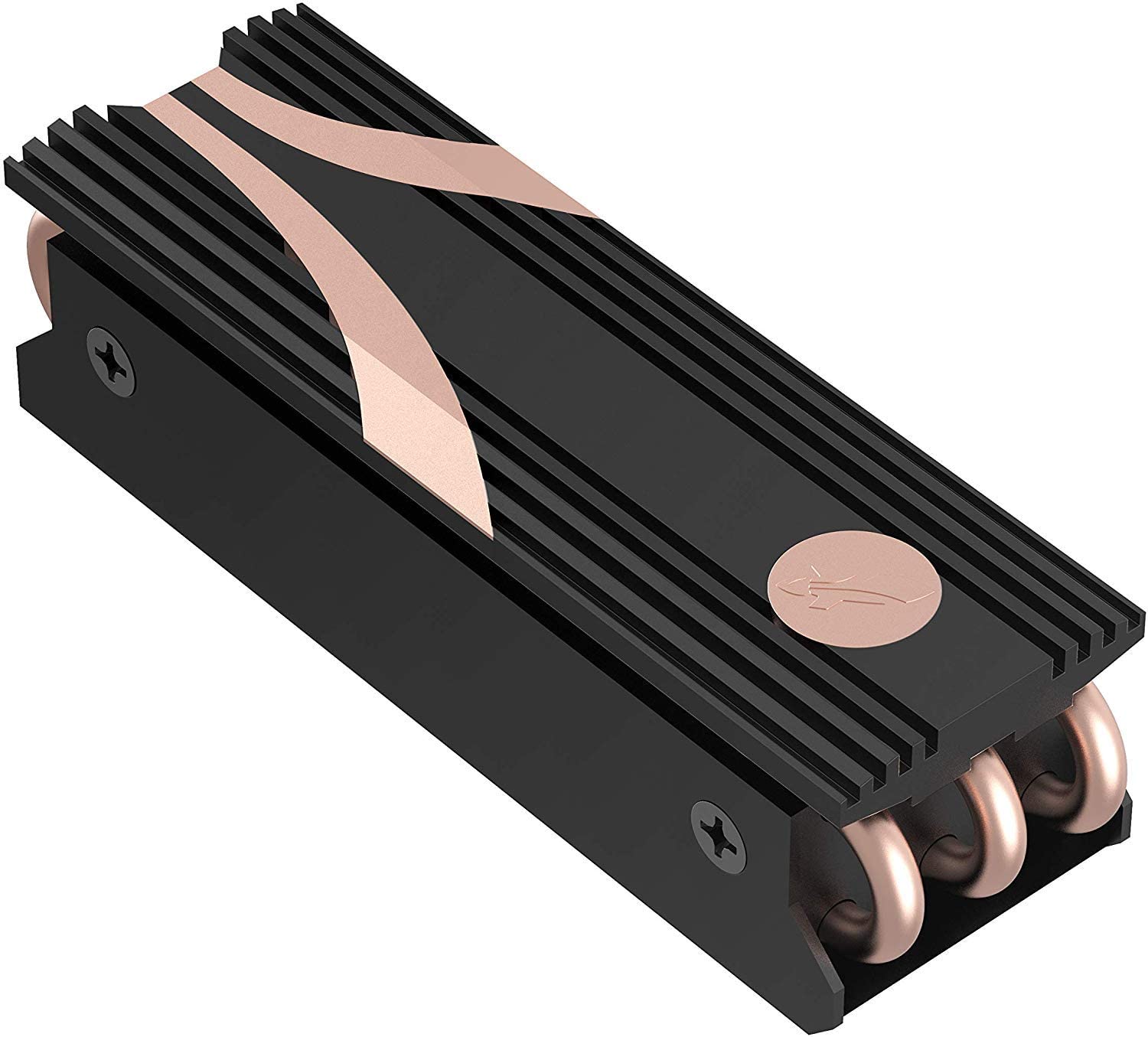[SOLVED] Best Heat Sink for Samsung 980 PRO?
- Thread starter george198011
- Start date
-
- Tags
- samsung ssd 980 pro ssd
You are using an out of date browser. It may not display this or other websites correctly.
You should upgrade or use an alternative browser.
You should upgrade or use an alternative browser.
- Status
- Not open for further replies.
Solution
Those temps are fine.actually my work is related to rendering and my ssd temp is around 40-50 degree Celsius. I heard heatsink cools down the temp thats why I am looking for it.
Here is one review site there are others.

The 5 Best Heatsinks For NVMe M.2 Storage Devices - Tested And Ranked
For most people, SATA SSDs are a major upgrade over a traditional hard drive. When you've been using a hard drive for a couple of years, the jump from
 appuals.com
appuals.com
Welcome to the forums, newcomer!
Mind sharing the make and model of your motherboard? The motherboard should come with a heatsink of it's own. If you're working with a laptop, I don't think you're going to have room in the chassis to have a heatsink. As for suggestions, you might want to see the EKWB heatsink for M.2 SSD's.
Mind sharing the make and model of your motherboard? The motherboard should come with a heatsink of it's own. If you're working with a laptop, I don't think you're going to have room in the chassis to have a heatsink. As for suggestions, you might want to see the EKWB heatsink for M.2 SSD's.
GoboII
Prominent
Worth noting that a heatsink for an SSD is purely decorative in most scenarios; SSDs just don't really produce enough heat to need one.Can anyone suggest to me a good Heat Sink for Samsung 980 PRO?
Also, I should point out that the 980 PRO, while by no means a bad drive, is extremely expensive. Its high sequential performance won't help a vast majority of consumers; advertised speeds are sequential and not random, with random performance being what has more of an effect on boot/load times. So nothing wrong with the 980 pro, but you should consider whether it would be perceivably better than a drive that costs a third of what the 980 does.
Either way, I wish you luck with your build.
My motherboard is Asus ZI70-P, it do not have any heatsink 🙁Welcome to the forums, newcomer!
Mind sharing the make and model of your motherboard? The motherboard should come with a heatsink of it's own. If you're working with a laptop, I don't think you're going to have room in the chassis to have a heatsink. As for suggestions, you might want to see the EKWB heatsink for M.2 SSD's.
actually my work is related to rendering and my ssd temp is around 40-50 degree Celsius. I heard heatsink cools down the temp thats why I am looking for it.Worth noting that a heatsink for an SSD is purely decorative in most scenarios; SSDs just don't really produce enough heat to need one.
Also, I should point out that the 980 PRO, while by no means a bad drive, is extremely expensive. Its high sequential performance won't help a vast majority of consumers; advertised speeds are sequential and not random, with random performance being what has more of an effect on boot/load times. So nothing wrong with the 980 pro, but you should consider whether it would be perceivably better than a drive that costs a third of what the 980 does.
Either way, I wish you luck with your build.
Those temps are fine.actually my work is related to rendering and my ssd temp is around 40-50 degree Celsius. I heard heatsink cools down the temp thats why I am looking for it.
Here is one review site there are others.

The 5 Best Heatsinks For NVMe M.2 Storage Devices - Tested And Ranked
For most people, SATA SSDs are a major upgrade over a traditional hard drive. When you've been using a hard drive for a couple of years, the jump from
 appuals.com
appuals.com
GoboII
Prominent
Flash storage is rated for higher temperatures than those. You're fine.actually my work is related to rendering and my ssd temp is around 40-50 degree Celsius. I heard heatsink cools down the temp thats why I am looking for it.
but there are people saying less temp they are having with their ssd.Flash storage is rated for higher temperatures than those. You're fine.
Flash storage is rated for higher temperatures than those. You're fine.
As you were told, your temps are perfectly fine. Adding a heatsink may really do nothing to improve anything, from a practical perspective.
If you want one for aesthetics (looks), then something like this offerings would be okay:
https://www.amazon.com/EKWB-EK-M-2-NVMe-Heatsink-Black/dp/B073RHHYCM
https://www.amazon.com/Sabrent-2280.../B07TN2RX2K/ref=psdc_2998409011_t3_B073RHHYCM
If you want one for aesthetics (looks), then something like this offerings would be okay:
https://www.amazon.com/EKWB-EK-M-2-NVMe-Heatsink-Black/dp/B073RHHYCM
https://www.amazon.com/Sabrent-2280.../B07TN2RX2K/ref=psdc_2998409011_t3_B073RHHYCM
thankyou  , I want to know one more thing tomsguide and tomshardware is one? I mean you just replied me the same lines there also. So, using both for same queries will take me to the ban of my ID?
, I want to know one more thing tomsguide and tomshardware is one? I mean you just replied me the same lines there also. So, using both for same queries will take me to the ban of my ID?
Please guide.
 , I want to know one more thing tomsguide and tomshardware is one? I mean you just replied me the same lines there also. So, using both for same queries will take me to the ban of my ID?
, I want to know one more thing tomsguide and tomshardware is one? I mean you just replied me the same lines there also. So, using both for same queries will take me to the ban of my ID? Please guide.
Different sites with different topics. TH is really more PC oriented. TG more "gadget" oriented.thankyou, I want to know one more thing tomsguide and tomshardware is one? I mean you just replied me the same lines there also. So, using both for same queries will take me to the ban of my ID?
Please guide.
For your question, TH is the better site.
Just didn't want you/others to get conflicting recommendations.
No. That only applies to Sata SSD, or Gen3 NVMe which come with heat-tape in the form of the sticker on top. It most definitely does not apply to Gen4 NVMe. Gen4 (Samsung 980 Pro) requires a heatsink if used on pcie4.0 just for heat management and preventing the controller from burning up since it will run hotter when under heavy load than the Nand.Worth noting that a heatsink for an SSD is purely decorative in most scenarios; SSDs just don't really produce enough heat to need one.
SSDs have a preferred range of operation, roughly around the 50-70° range, Data written at a higher temp, then allowed to cool off a little before power off has a much higher data retention period than data written cold. For instance data written at 40°C and the drive is allowed to cool to 30°C, the data can last upto 52weeks. Data written at 50° and immediately powered off can last as little as 9weeks. Data written at 30° and powered off at 50° can last as little as a week.
WD, Intel and Micron (that I know of) have longetivity tested drives vs temps, and the lowest MTBF (Mean Time Before Failure) or highest, soonest failure rate is from drives in the 40°C range or lower. Longest MTBF, lowest failure rate is in drives in the 50-70°C range. (depending on hdd or ssd)
So NVMe temps of @ 50°C are about perfect.
Last edited:
sonofjesse
Distinguished
I have a heat sink on my 980 pro. 41 C at the moment it varies. people worry too much about temps.
980 seems to run hotter than past samsung and other drives.
its still way under thermal limit you will be fine.
980 seems to run hotter than past samsung and other drives.
its still way under thermal limit you will be fine.
- Status
- Not open for further replies.
TRENDING THREADS
-
News Edward Snowden slams Nvidia's RTX 50-series 'F-tier value,' whistleblows on lackluster VRAM capacity
- Started by Admin
- Replies: 86
-
Review Nvidia GeForce RTX 5080 Founders Edition review: Incremental gains over the previous generation
- Started by Admin
- Replies: 216
-
-
Review Nvidia GeForce RTX 5090 Founders Edition review: Blackwell commences its reign with a few stumbles
- Started by Admin
- Replies: 231
-
Discussion What's your favourite video game you've been playing?
- Started by amdfangirl
- Replies: 4K
-
News Nvidia's RTX 50-series drivers feel half-baked, focus too much on MFG
- Started by Admin
- Replies: 81

Space.com is part of Future plc, an international media group and leading digital publisher. Visit our corporate site.
© Future Publishing Limited Quay House, The Ambury, Bath BA1 1UA. All rights reserved. England and Wales company registration number 2008885.
